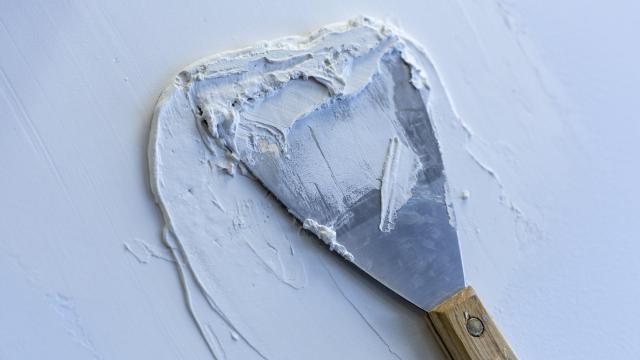Drywall regularly sustains all kinds of damage, from holes made while hanging shelves and pictures to dings from protruding chair backs and door knobs, but luckily it’s almost as easy to repair as it is to break. Fixing dents and holes in drywall yourself can save you some money and make you feel downright handy, whether you’re looking to spruce up a room or keep your security deposit. Here’s the best way to tackle those cracks with confidence (and a little spackle).
Gather your tools and materials
For small drywall repairs, you will need a utility knife, a putty knife, and some sandpaper. For larger holes, you’ll also need a hand saw, a screw gun, a piece of scrap timber, a piece of drywall scrap, and some drywall screws. For repairs of either size, will also need some spackle, joint compound, gloves, and a damp rag.
Fixing small blemishes in drywall
For small dents or holes like those left by nails, spackle and a putty knife is all you’ll need. Make sure the surface is clean, take a small amount of spackle, and push it into the hole with your putty knife. Scrape the wall with the knife to remove excess spackle and level off the now-filled hole. Once the spackle is dry, sand the area smooth. (If you’re not sure how long your product takes to dry, you can consult the package, but most will be dry within half an hour.)
Filling medium-sized holes in drywall
For larger holes (like one left by a door knob or perhaps a dramatic punch), a patch kit is useful. You can buy one, sure, but you can also make your own patch with mesh drywall tape and some spackle. First, put the mesh over the opening you wish to cover, cutting the tape just about an inch larger than the opening of the hole. Next, spread a layer of spackle over the hole, tapering off at the edges to more easily blend with the surface of the wall. A patch this size may need to dry for longer than a smaller amount of material would, so be sure to consult the package to leave adequate drying time. If the spackle shrinks, you may need to apply a second layer to fill the hole completely. Once the spackle is dry, sand the area smooth.
Patching larger holes in drywall
If you have a hole that’s larger than four inches or so, you’ll need a piece of drywall to fill it. Before taking any other steps, check for wires, outlets, or switches near your intended repair. If there’s a chance you could come into contact with anything that carries a current, shut off the power to your work area first, just in case. Use a square or a tape measure and straight edge to mark out the area immediately around the hole to be removed — mark out a square or rectangle shape to make it easier to fit your patch. Keeping an eye out for wires, use your drywall saw to cut out the area for your patch.
Cutting and securing your patch
Once you have your opening cut, it’s time to install a support for your patch. This can be as simple as scrap of lumber at least 2cm thick and 5cm wide. Cut your support to 5 or 7 cm longer than the width of your opening. Then, angle your support to fit it through the hole and inside the drywall — roughly in the middle of the hole — and screw it into place above and below the hole using drywall screws. Next, cut your scrap of drywall about a quarter inch smaller than the opening in the wall. Use your drywall tape to position the patch in the opening and screw it into your support. Finally, apply a thin layer of joint compound over top of the patch, making sure to cover the seams and taper off the joint compound as you go. Allow time to dry as directed on the package, then sand smooth.
Smoothing cracks in drywall
To fix a crack in the drywall, use your utility knife to spread the crack open a little bit so you have some room to push some spackle into the opening. Then, use your putty knife to smooth spackle over the crack, scraping away the excess. Allow your spackle to dry and then sand smooth. Make sure that you account for the whole area affected by the crack — sometimes, cracks can spread and it might be hard to see the very fine edges. It’s important to cover the whole crack to keep it from opening back up.
Paint and finish
The last step for any of these repairs is to touch up the paint. If your paint is old, you’ll likely need to repaint the whole wall to make the colour match. (Priming the wall first will help cover the patch; paint-and-primer in one probably won’t do the trick.) If your patches are small and your paint is new, you can probably get by with a small touch up. Even if you have to buy new paint, your walls (and your wallet) will thank you.

Leave a Reply
You must be logged in to post a comment.